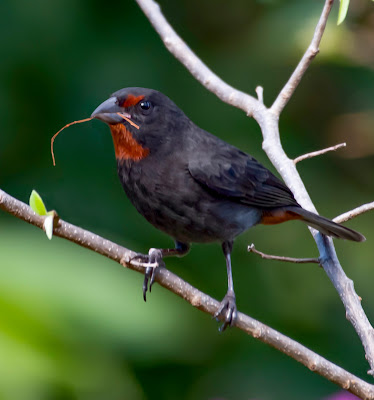 |
| Two bullfinch babies quietly opened their mouths hoping for food |
When we came back to our house late last month, I saw that there was a nest in the corner rafters of our screened-in deck downstairs. We had left a door open at one end while we were gone so it wouldn’t be blown out if a bad storm came by. We soon discovered that a couple of Lesser Antillean Bullfinches had used the cozy deck area during our absence.
When I first noticed the nest, I assumed it was empty. I didn’t see any birds around, and it was right above where we usually sit to eat dinner, so I was planning to remove it.
However, when I stood up on a chair and peeked inside, I thought I saw something moving down in the bottom. I looked more closely, and saw a small, gray, slightly twitching pile, and an unopened eye on what seemed to be a newly hatched chick. Oh dear.
When there is consistent warm weather and an abundance of food, most resident birds can breed throughout the year. In the past we have come back in the fall and seen remnants of nests around the house, but mostly by late October the birds were finished, and the nests had fallen down. They never really seemed very sturdy anyway.
You can see both the parents gathering material to build nests and working on it clumsily, apparently without a lot of construction expertise. Still they do manage to reproduce successfully and are abundant on many of the smaller eastern Caribbean islands.
The females are light colored, with a mix of tan and beige feathers.
 |
| A female bullfinch gathered nesting material from a pygmy date palm tree |
The males are black with red patches on their throats, above their eyes, and under their tails. They are quite aggressive, at least about boxing out the Bananaquits at the sugar feeder when I fill it. Yet it turns out they are good partners and providers when it comes to parenting.
 |
| Male bullfinches also bring sticks for the nest. |
We mostly stayed off the deck after I looked into the nest. From inside I saw both parents through the screen. They seemed to be consulting, and then decided that it was okay to fly across the deck to the nest. We were hot and dark inside, though, so I did sometimes open the door from the kitchen to get some more air and light.
One day about a week later I looked out and noticed something moving in the nest. Of course my first thought was to get my camera. Sitting far back inside the house, I used my telephoto lens to check things out from a distance. Now the nestlings had gotten bigger, and I saw two mouths sticking out of the nest, not making any noise yet, but obviously hoping one of the parents would come with food. The babies’ mouths have yellow lines around the outside, and are bright red inside, so the parents have clear targets for dropping the food.
I figured that one of the parents would show up soon, so I sat there very quietly, holding my camera. I actually had to wait for almost an hour. A wildlife stakeout operation in my own kitchen. Then suddenly the dad appeared with some food in his beak, and when I raised the camera to take a photo, he turned and gave me a hard look.
 |
| The bullfinch father came by to feed the babies |
After that look, I kept all the doors to the deck closed. I didn’t want the parents to get scared off and abandon the nest. I couldn’t see very much from inside, so I wasn’t sure what was happening. At one point the nest seemed to be falling apart, and I wondered if the parents were still coming.
Then about two weeks after we got back, I saw some movement outside the nest. I opened the door to the deck, and just then a baby bird dropped onto the chair below the nest, and then flopped onto the floor.
 |
| When the baby bird dropped out of the nest it couldn’t fly |
I was worried about its safety, but the dad quickly appeared and gradually led the baby along the deck and out the door into the low bushes next to the house. I was very relieved.
There was no further activity around the nest after that. I hopedt that the other baby had already fledged while I wasn’t around. I was also happy to be able to open the doors so we could use the deck and cool down the house a bit.
I could still hear them calling to each other outside though. Like many other young birds, the bullfinch babies will beg for food from the parent for quite a while, even after they have learned to fly.
 |
A hungry bullfinch chick appealed to its mother for food |
It would be interesting to hear about any birds that have chosen to nest on your decks.


































